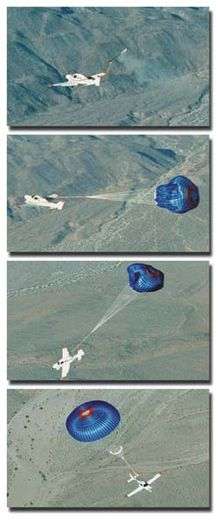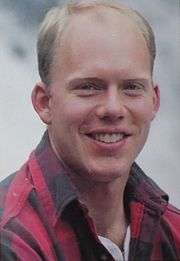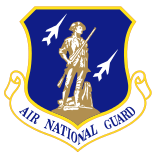Scott D. Anderson
| Scott D. Anderson | |
|---|---|
|
Anderson circa 1990 | |
| Born |
May 2, 1965 Boston, Massachusetts |
| Died |
March 23, 1999 (aged 33) Duluth, Minnesota |
| Cause of death | Plane crash |
| Nationality | United States |
| Education | Stanford University |
| Alma mater | University of Minnesota |
| Occupation | Air National Guard F-16 pilot, 179th Fighter Squadron flight instructor, Cirrus Aircraft test pilot & flight operations officer, inventor, canoeist, author, engineer |
| Years active | 1987–1999 |
| Known for | Cirrus Airframe Parachute System test pilot; Distant Fires (novel); Scott D. Anderson Leadership Foundation (scholarship) |
| Home town | Duluth, Minnesota |
| Religion | Christian |
| Awards |
American Library Association Best Book For Young Adults—Distant Fires (1991) Minnesota Aviation Hall of Fame Inductee (2010) |
Major Scott Douglas Anderson (May 2, 1965 – March 23, 1999) was a late 20th-century American polymath: Air National Guard F-16 pilot, instructor pilot, general aviation test pilot, Flight Operations Officer, engineer, inventor, musician, football player, outdoor adventurist, and award winning author. He is perhaps most notable for his achievements flight testing the first certified whole-plane parachute recovery system, which is credited for saving over 130 lives as a standard equipment on Cirrus Aircraft's line of single-engine aircraft.
Anderson was killed near the Duluth International Airport while testing the first production model Cirrus SR20. He became posthumously inducted into the Minnesota Aviation Hall of Fame in 2010 for his contributions to the development and advancement of aviation in the state. The Scott D. Anderson Leadership Foundation was created in his honor.[1][2][3]
Early years
Scott Anderson and his family moved to Duluth, Minnesota when he was six years old. He graduated from Duluth East High School as a star football player and went on to attend the University of Minnesota. As an undergraduate engineering student-intern and a member of Minnesota Power's Research and Development team, Anderson earned recognition as co-inventor on a U.S. patent. He continued his college career later at Stanford University, where he led an undergraduate team to build a two-person submarine. Anderson graduated from Stanford with degrees in Mechanical Engineering and History.[1][2][4]
Career
In 1987, the summer after graduating, he and his friend Steve Baker planned a marathon canoe trip from Duluth to York Factory on the Hudson Bay.[5] After completing the 1,700-mile-long exploit, Anderson wrote his first book, Distant Fires, published in 1990, an autobiographical adventure story based on his experiences during the trip. Distant Fires was widely received by the local community at the time of its release—the Duluth News Tribune describing it as a marvelous "voyage of discovery"—and went on to win the American Library Association Best Book for Young Adults Award in 1991.[6][7]
Anderson was known to have been a talented saxophonist, playing for multiple jazz bands around Duluth in the late ‘80s and early ‘90s. He then moved from the United States to Salzburg, Austria to play professional American football, before returning to become a pilot flying F-16s for the Air National Guard, as well as an instructor pilot with Duluth's 179th Fighter Squadron.[2] His second publication, and first novel, Unknown Rider (1995), was a fictional manifestation of his experience achieving the title “Fighter Pilot”. He summed up his writing process saying, “When I was training to fly the F-16 at Kingsley Field in Oregon, each evening, after a day of flying fighters, I sat down and typed a little bit of this book… All I had to do was invent a few characters, put them in an airplane, and make them the heroes of the stories that filled the air.”[8]
Cirrus Aircraft

In 1996, Anderson's career path led him to Cirrus Design (now called Cirrus Aircraft), a newly Duluth-landed general aviation startup founded by two brothers, Alan and Dale Klapmeier, hailing from a rural southern Wisconsin farm. He was named Director of Flight Operations along with Chief Test Pilot for the company, contributing his efforts to the early developmental stages of the Cirrus SR20 single-engine composite aircraft. In addition to all-compiste construction, the SR20 introduced the aircraft manufacturing industry to a number of innovative new designs, including a single power-lever that adjusts both throttle and propeller RPM, a side-yoke flight control system, a spin-resistant wing design, and a large LCD screen for the avionics.[9][10][11] In 1997, Anderson became the lead test pilot on a ground breaking safety innovation by Ballistic Recovery Systems and Cirrus Aircraft. The feature was titled CAPS (Cirrus Airframe Parachute System), and acted as a parachute recovery device installed on the SR20 that was designed to lower the entire aircraft safely to the ground after a loss of control or structural failure.[5][12]
Anderson worked closest on the project with fellow Cirrus test pilot Gary Black,[3] who also formally flew jets for the military, as well as the company's Chief Engineer, Paul Johnston, who played a crucial role in the design process of the CAP system.[13][14] CAPS testing began by the summer of 1998. The Cirrus team went out to the high desert of California where Anderson would make the first flight. He deployed the parachute multiple times during dives and spins, to simulate recovery after a midair collision or after spatial disorientation, and from level flight to resemble engine failure. At this time Cirrus only had two SR20 prototypes, so in order to test the parachute repeatedly Anderson would restart the engine mid-air while descending under the parachute, cut the chute loose and land the plane normally for it to be tested again (ground-impact testing took place with a mockup that would be dropped at the calculated descent-velocity and measured based on sustained damage to the fuselage).[14][15] Anderson successfully made all seven of the company's in-flight test deployments of CAPS. The SR20 became FAA approved and typed certified in October 1998, making Anderson the first pilot in history to successfully test a certified aircraft equipped with a ballistic parachute.[16][17][18]
Death
The following year, on 23 March 1999, Anderson died while putting the first production SR20 aircraft through experimental test flights before it went on sale. The purpose of the flight was to perform routine torture-test maneuvers and assess changes to the aileron if there were any issues. The incident occurred after the plane's aileron had jammed.[13][19] Anderson was about 4 nautical miles out from the Duluth International Airport at the start of the flight when he radioed the control tower that he was returning due to a problem. At about 1.5 nautical miles from the airport, he declared an emergency. Less than 400 meters out, Anderson crashed near the medical facility on the prison grounds; he died later that day in the hospital.[17] The plane Anderson was flying had not yet been equipped with the standard CAPS that would come on every aircraft.[13][19] Due to Cirrus being in very early production phase, the company was 10 days away from receiving production model chute systems at the time of Anderson's death. Cirrus has never test-flown an aircraft without a parachute since.[3]
Posthumous recognition

The late 18-term Minnesota Congressman Jim Oberstar paid tribute to Anderson shortly after his death, calling him a "hero" and a "pioneer in general aviation". Oberstar went on saying, "Scott made a profound difference to the State of Minnesota and to the national aviation community".[5] Cirrus Aircraft Co-Founder and CEO Dale Klapmeier spoke at Anderson's induction into the Minnesota Aviation Hall of Fame on 24 April 2010, stating, "Scott was an exemplary pilot and person. During his tenure at Cirrus, he made considerable contributions to the company, the industry, and aviation safety that many people still benefit from today… To date, 17 CAPS deployments have saved 35 lives due to Scott's pioneering work."[20]
Anderson has been referenced multiple times in national articles and columns such as The Atlantic Monthly and The New York Times by journalist, author and former speechwriter for President Jimmy Carter, James Fallows. He has often been credited by Fallows as being a "Renaissance man" and "beloved, charismatic figure of Duluth"; Anderson was also a strong supporting theme in his 2001 novel, Free Flight: Inventing the Future of Travel.[13][14][19]
Legacy
In the months following his death, Cirrus continued on to redesign the aileron in order to prevent the problem that killed Anderson, and sold their first SR20 in July 1999.[13][19] The SR20's successor, the Cirrus SR22, became the worlds best-selling single-engine four-seat airplane in 2003 and has held the title for 13 years in a row.[21] As of March 24, 2016, there have been 64 CAPS deployments saving 129 lives.[22][23]
The Scott D. Anderson Leadership Foundation (SALF) was established in late 1999 and is a fund of the Duluth Superior Area Community Foundation. It allows a group of high school students each year to receive scholarships dedicated to the delivery of high-quality, value-based leadership training.[24]
Anderson is memorialized by the "ANDOE" waypoint for the outer marker on ILS runway 27 approaching Duluth International Airport.[25]
Personal life
Anderson was a practicing Christian throughout the entirety of his life.[1] On the SALF organization's website, it lists several of its "Guided Values and Principles", focusing mostly on promotion towards the common good, community, affirming the dignity of individuals, encouraging creativity, mentorship, pursuing goals, and strengthening one's character, stating:
| “ | These principles and values emanate from the Biblical foundations of the Judeo-Christian faith, which were formative in the life of Scott Anderson.[26] | ” |
He is survived today by his wife, Laurie, their son, Evan (born 1999), his siblings, Catherine and Todd, as well as parents, Paul and Carol.[27][28]
The Anderson family resides in Duluth, Minnesota.
Bibliography
- Distant Fires: From Duluth to Hudson Bay (with Les Kouba as illustrator, 1990)
- Unknown Rider (with Andrea Dwyer as illustrator, 1995)
- The Mosquito Book (with Tony Dierkens, 1998)
See also
- List of firsts in aviation
- Society of Experimental Test Pilots
- Robert F. Overmyer
- Canoeing with the Cree - 1935 book by Eric Sevareid, served as the inspiration for Distant Fires
References
- 1 2 3 Scott D. Anderson Leadership Foundation – Who Is Scott Anderson? http://www.salfleaders.com/about/scottanderson.htm
- 1 2 3 Minnesota Aviation Hall of Fame – Inductees http://www.mnaviationhalloffame.org/hofpages/hofa1.html
- 1 2 3 Passie, Peter (23 April 2010). "Pilot Scott Anderson Remembered". Duluth News Tribune. Retrieved 11 July 2015.
- ↑ http://www.salfleaders.com/support/index.htm
- 1 2 3 Capitolwords – Tribute To Scott Anderson – James L. Oberstar http://capitolwords.org/date/1999/03/25/E578_tribute-to-scott-anderson/
- ↑ Book Awards: ALA Best Book For Young Adults http://www.librarything.com/bookaward/ALA+Best+Books+for+Young+Adults
- ↑ University of Minnesota Press – Distant Fires: Duluth to Hudson Bay http://www.upress.umn.edu/book-division/books/distant-fires
- ↑ Greater St. Louis Air and Space Museum – Book Review: Unknown Rider by Major Scott D. Anderson, USAF http://airandspacemuseum.org/news/?p=1081
- ↑ "Top 100 Airplanes:Platinum Edition". Flying. Retrieved 2014-04-05.
- ↑ Robert Goyer (2011). "10 Ways that the SR22 Changed Flying".
- ↑ Robert Goyer (2014). "Top 25 Coolest Aircraft".
- ↑ Flying Magazine – After 10 Years Cirrus Chute Controversy Persits http://www.flyingmag.com/blogs/going-direct/after-10-years-cirrus-chute-controversy-persists
- 1 2 3 4 5 Fallows, James (November 21, 1999). "Turn Left at Cloud 109". The New York Times. Retrieved 2014-07-15.
- 1 2 3 Fallows, James (June 2001). "Freedom of the Skies". The Atlantic. Retrieved 2014-07-15.
- ↑ Cirrus Aircraft. "Guide to the CIRRUS AIRFRAME PARACHUTE SYSTEM" (PDF). Retrieved 2015-05-02.
- ↑ Federal Aviation Administration. "Type Certification Data Sheet A00009CH" (PDF). Retrieved 2014-07-15.
- 1 2 Higdon, Dave (March 31, 1999). "Cirrus SR20 demonstrator kills test pilot in prison crash". Flighglobal. Retrieved 2014-07-15.
- ↑ BRS – BRS Milestones http://www.brsaerospace.com/brs_history.aspx
- 1 2 3 4 Fallows, James (March 7, 2007). "Lidle lawsuit update: the myth of 'aileron failure'". The Atlantic. Retrieved 2014-07-15.
- ↑ Aero-News Network http://www.aero-news.net/index.cfm?do=main.textpost&id=e83bcb54-7b29-4950-876b-9ec778bfdf0d
- ↑ Cirrus Aircraft News (February 11, 2015). "Cirrus Aircraft Deliveries in 2014 Drive Strongest Performance in Six Years". Retrieved February 15, 2015.
- ↑ "CAPS History by Cirrus Owners & Pilots Association". Retrieved 2014-07-15.
- ↑ Cirrus Aircraft – CAPS Training http://cirrusaircraft.com/caps/
- ↑ Scott D. Anderson Leadership Foundation – About http://www.salfleaders.com/about/index.htm
- ↑ Cirrus Owners and Pilots Association. "Cirrus Fatal Accidents".
- ↑ Scott D. Anderson Leadership Foundation - Guided Principles and Values http://www.salfleaders.com/about/guidingprinciples.htm
- ↑ Scott D. Anderson Leadership Foundation – History http://www.salfleaders.com/about/history.htm
- ↑ Schneider, Kim (30 June 2016). "Forum helps local high school students build leadership skills". Duluth News Tribute. Retrieved 13 November 2015.
External links
- Scott D. Anderson Leadership Foundation website
- Minnesota Aviation Hall of Fame website
- Cirrus Design Corporation History and Background Information
- Video of Scott Anderson spinning the SR20 during inflight CAPS testing
- Greater St. Louis Air and Space Museum book review: Unknown Rider

